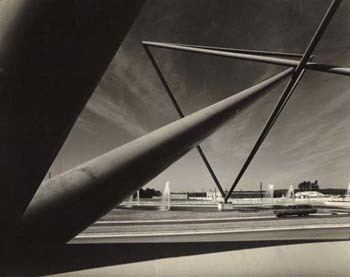Nationality American Period Contemporary art | Role Artist Name Peter Forakis | |
 | ||
Education | ||
atlanta gateway by peter forakis
Peter Forakis (born September 22, 1927, in Hanna, Wyoming, died November 26, 2009 in Petaluma, California) was an American artist known as an abstract geometric sculptor. The son of a Greek immigrant, he grew up on the Wyoming prairie until the age of 10 when his family moved to Oakland, California. Eventually they settled in Modesto, California. Forakis was in the Merchant Marines from 1945-50. He served in the US. Military in Korea and Japan from 1951-53. He earned his B.F.A. at the California School of Fine Arts (San Francisco Art Institute) in 1957.
Contents
- atlanta gateway by peter forakis
- Peter forakis small stride
- Art
- Teaching
- Happenings
- Public collections
- References
Peter forakis small stride
Art
In 1955 Forakis created the poster for the Six Gallery reading by Allen Ginsberg, Philip Lamantia, Michael McClure, Gary Snyder, and Philip Whalen, MCed by Kenneth Rexroth. In 1958 Forakis moved to New York City. It was during this time in New York in the late 1950s-1960s that Forakis emerged as a prominent member of the art world, and, along with artists Mark di Suvero, Ed Ruda, Dean Fleming, Robert Grosvenor, Anthony Magar, Tamara Melcher, Forrest “Frosty” Myers, David Novros and Leo Valledor, he founded the Park Place Gallery (1963–67), a unique artists’ co-op space. Park Place became the prototype for experimental art spaces of the 1970s.

Forakis was a ceaseless experimenter and was conducting his own research during the Park Place Gallery time period. Although he began as a painter, his paintings became sculpture. His work quickly evolved in a 3-dimensional direction, with a seminal series of “3D paintings” (1959–62) consisting of brightly painted abstract constructions made from mostly found timber which literally “came off the wall.” Sadly, few of these works remain. Forakis became fascinated by geometry and his focus became sculptural. San Francisco Chronicle Art critic Kenneth Baker credits Forakis as the “originator of geometry-based sculpture from the 60s”. In an article by Joanne Dickson titled “Profile: Peter Forakis” in the Winter 1981 edition of Ocular Magazine Forakis said, “Geometry…is a natural law that exists not only in my thinking and my blood, bones, and marrow, but in the universe and all its matter.” Forakis embarked on his lifelong exploration of the cube and hypercube along with Four-Dimensional theories. Since the late 1950s Peter Forakis has been a prolific producer of sculpture based on geometric shapes such as cubes, spheres, octahedrons and rhomboids. Some of his best known pieces include Daedules & Icarus (1963), Magic Box (1966) and Hyper Cube,1967 (Walker Art Center).

In 1967 Forakis received his first monumental scale commission. Atlanta Gateway, one of the largest existing works of modern sculpture anywhere measuring 100 feet by 200 feet by 100 feet of tubular steel, spans a major traffic artery in Atlanta, Georgia’s Southwest Industrial Park.
By the early 1970s Forakis had begun experimenting with his “slots” technique, one of his signature achievements notable both as a unique language of examining geometry and for fabricating large scale works in steel without welding. Cutting slots into steel and sliding sheets together allowed large sculptures to be assembled using only gravity and the weight of the material. Archimedes Cube, (series, beginning in 1968) a signature piece for Forakis, has no welds, only slots. Of his monumental slotted sculptures are Sokar: the Egyptian Key (1974), and Jack London (1982) owned by the Oakland Museum and located in the Oakland Estuary, Oakland, California.
He exhibited his work in major sculpture exhibitions in museums including the Los Angeles County Museum of Art (LACMA) 1967 American Sculpture of the Sixties exhibition. His work has been seen on both coasts, across the US, and in Europe and Asia. He also won numerous grants.
Teaching
Happenings
Public collections
Hirshhorn Museum and Sculpture Garden, Smithsonian, Washington, DC.;
Dartmouth College, New Hampshire
Hartwood Acres Art Center, Allegheny, Pennsylvania;
University at Buffalo Art Galleries;
University of Kentucky Art Museum;
Oakland Museum, Oakland, California;
Berkeley Art Museum, Berkeley, California;
San Francisco Museum of Modern Art, San Francisco, California;
Denver Art Museum, Denver, Colorado;
Fort Wayne Museum of Art, Fort Wayne, Indiana;
Interland Executive Park, Walnut Creek, California;
Stamford Museum and Nature Center, Stamford, Connecticut;
Walker Art Center, Minneapolis, Minnesota
